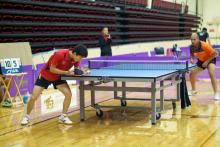The Future of Table Tennis
Today, many coaches in the US are teaching outdated table tennis techniques from the 80’s and 90’s. The strokes and strategies that once were used to reach a world class level are now much less effective as the old has been replaced with better equipment, more efficient strokes, and more advanced playing styles. So, I want to say that coaches in the US should do their best to keep up to date.
More importantly, coaches in the US should LOOK TO THE FUTURE.
If the US is ever going to rise to the top, then we must be AHEAD OF THE GAME.
So how do we stay ahead of the game?
We stay ahead of the game by thinking how the game is currently played and thinking what advancements can beat the current game of the world’s top players. In this article, I will give my opinion about the future of table tennis.
Ball Placement
Previously, players positioned themselves near the backhand side of the table and covered most of the table with their forehands. The ideal placement previously was using angles. Now that players are staying closer to the middle and covering the court with both backhand and forehand, the target has been more of the middle transition ball. However, the ball placement that has not been properly trained is the wide backhand. At the beginner, intermediate, advanced, and world class level, many players play to the backhand, middle, forehand, and wide forehand. Very few players have trained to hit to the wide backhand. Previously, when the players were positioned near the backhand corner, this was very ineffective. Now that the players are positioned near the middle of the table, the wide backhand is clearly the most effective place to play. So how do you develop this? You develop it with intentional practice. Design drills that force you to target pushing, flipping, looping, and counterlooping to the wide backhand. So that you don’t fall in the same trap, you must also develop backhand footwork yourself so that you can be ready when your opponent does the same back to you!
Style of Play
The future dominant style of play is the…..all-around player. Previous statistics showed that 75% of the time, whoever had the first powerful attack won the point. For offensive players, playing defense used to be an issue. With an improvement in both offense and defense, the world’s top players will be able to win points regardless of the situation. So I feel that the best players will have strong loops, solid blocks, as well as the ability to chop, lob, and counterloop with equal proficiency. You can already see a shift toward this at the world’s top level. Previously, players had strong strengths and some weaker points. Now many of the world’s best are developing powerful loops as well as somewhat solid defense with both active and passive blocks. With a very short swing, a blocker can borrow the speed and spin from the attacking player. An active block can be just as fast as a powerful loop. Passive blocks will be immediately destroyed. Active blocks will turn into offensive weapons and will be a main key in the future.
Variations
Starting in the late 80’s, Waldner won many titles using unique variations in serving, receiving, looping, and blocking with speed variation, spin variation, and depth variation. After the rein of Waldner, the variations have somewhat been lost as sheer power shots have dominated. I feel that the future dominant style will have power shots but also feature variation loops and a variety of other creative shots in both serve, receive, and short game.
Fitness
In the future, speed and strength will become increasingly important. Foot speed and racket speed will become more important for faster rallies and better timing. Body strength will become more important for generating more spin and power on all the shots. Conditioning will become increasingly important for more intense training sessions and injury prevention.
Multi-Tasking
Many training centers currently train young players in one particular skill for months and months….such as basic forehand or footwork. In the future, the best players will be the ones who learn many skills early. From age 6, players will learn about spin, develop variation loops, learn how to block, and learn how to play game tactics. By developing many skills at an early age, players will have a solid foundation on all aspects of the game and will progress much faster through their teen years than those who only learn a few skills early in life.
As I mentioned in the beginning of this article, if the US is ever going to rise to the top, then we must be ahead of the game. We stay ahead of the game by thinking how the game is currently played and thinking what advancements can be made to beat the top dogs!
The Future of Table Tennis

Check out my 5 predictions about the future...
Category:



